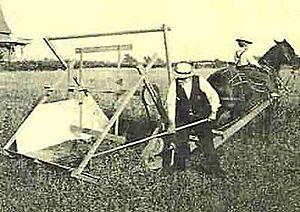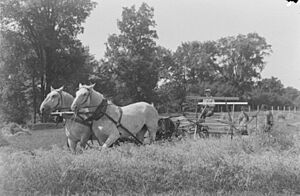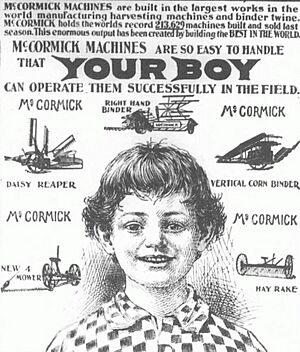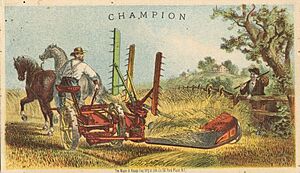Reaper facts for kids
A reaper is a special farm machine or even a person who cuts and gathers crops when they are ready to be harvested. This usually means cutting grain crops like wheat or rye.
Long ago, in ancient Roman times, people in what is now France used some of the first reaping machines. These early machines had a comb that collected the tops of the plants. A worker would then knock the grain into a box.
Today, most modern reapers cut grass. Many also gather it, either by laying it in rows or picking it up. Even more advanced machines, called combine harvesters, do much more. They not only cut and gather the grain, but also separate the seeds from the plant (this is called threshing). They then clean the seeds (winnowing) and put them into a truck or wagon. Combines are like the grandchildren of those first reapers!
Cutting hay is a bit different from cutting grain. For hay, the machine that cuts the grass is called a hay mower. If it also has a special part to help the hay dry faster, it's called a mower-conditioner.
In the past, people cut both grain and hay by hand using tools like scythes and sickles. This hand cutting was often called reaping.
Mechanical reapers changed farming a lot from the 1830s onwards. Later, these machines became even more advanced. They could not only cut the grain but also tie it into bundles called sheaves using wire or twine. These were known as reaper-binders.
Contents
Cutting Crops by Hand

Cutting crops by hand can be done in a few ways. People might pull the grain heads off by hand. More often, they use a sickle or a scythe to cut the stalks. A scythe with a special frame, called a grain cradle, helps gather the cut stalks.
Cutting grain is usually called reaping. Cutting grass for hay is called mowing. The dry, stiff stalks of grain plants need different blades than the greener grass used for hay.
After the grain stalks are cut, they are gathered into bundles called sheaves. These sheaves are tied with string or a twist of straw. Several sheaves are then leaned against each other to dry in the field. This group of sheaves is called a stook.
Once dry, the sheaves are collected from the field and stacked up. They are placed with the grain heads facing inwards and then covered with a roof of straw or a tarp. This big stack is called a rick. Later, the rick is taken apart, and the sheaves are threshed to separate the grain from the straw.
Collecting any grain that falls on the ground after reaping is called gleaning. Traditionally, people would pick it up by hand. Sometimes, farmers would let animals like chickens or pigs into the field to eat the spilled grain.
Today, hand reaping is rare in countries with modern farms. But it is still used where machines cannot go, like on narrow hillsides.
You might have heard of the "Grim Reaper." This is a famous image of death as a skeleton-like figure holding a scythe. It's a way of saying that death "harvests" the living, just like a farmer harvests crops.
How Mechanical Reapers Work
A mechanical reaper is a machine that uses engines or animals to harvest crops. These machines have been a very important part of modern farming. They helped farmers grow much more food.
Early Reapers in the U.S.
In the 1800s, many inventors in the United States tried to create better mechanical reapers. Their designs often competed with each other.
Obed Hussey from Ohio patented his Hussey Reaper in 1833. This machine was a big step forward. It only needed two horses and two people to operate it easily. The Hussey Reaper also left the field looking neat and clean after use.

The McCormick Reaper was designed by Cyrus McCormick in Virginia. His father, Robert McCormick, had tried to perfect a similar machine but couldn't. Cyrus took over the project and patented his horse-drawn reaper in 1834.
McCormick's reaper had several key parts:
- A main wheel frame.
- A platform sticking out to the side with a cutter bar. This bar had "fingers" and a moving knife that cut the grain.
- A "divider" at the end of the platform. This part separated the grain to be cut from the grain that would be left standing.
- A "reel" above the platform. This spun around to hold the grain against the knife and then throw it onto the platform.
- Horses walked beside the grain to pull the machine.
Cyrus McCormick said he invented his reaper in 1831, before Hussey. For many years, the Hussey and McCormick reapers competed in the market, even though they were quite similar. By the 1850s, the original patents for both machines ran out. This meant other companies could make similar reapers.
In 1861, the U.S. Patent Office looked into the history of the reaper. They decided that much of the success of reapers was thanks to Obed Hussey's improvements. They ruled that Hussey's family should be paid by those who made money from reapers. McCormick's patent was also renewed for another seven years.
Even though McCormick's reaper was a great invention, it took about 20 years to become widely used. This was because Hussey's reaper had a better cutting part, a "saw-like cutter bar," which cut stalks more effectively. McCormick's machine only became truly amazing when he got the rights to use Hussey's cutter-bar design around 1850.
Other reasons why farmers were slow to use mechanical reapers included:
- Farmers often preferred old, proven ways of doing things.
- Many new farm fields had rocks, tree stumps, or uneven ground. This made it hard for machines to work well and last long.
- Some farmers worried that machines would take away jobs from people who worked by hand.
Another strong competitor was the Manny Reaper, made by John Henry Manny. While McCormick is often given all the credit for inventing the mechanical reaper, it's more accurate to say he improved on ideas and combined them in a new way. He also benefited from his father's work and the help of Jo Anderson, a slave who worked for his family.
Reapers in the Late 1800s and 1900s

After the first reapers were invented, many other companies made slightly different versions. The Champion Reapers and Mowers, made by the Champion Machine Company in Ohio, were very popular in the 1880s. Springfield, Ohio, is still known as "The Champion City" because of this.
Over time, reapers developed into the reaper-binder, invented in 1872. This machine not only cut the crop but also tied it into sheaves. By 1896, it's estimated that 400,000 reaper-binders were being used to harvest grain.
Eventually, the reaper-binder was replaced by the swather and then the combine harvester. The combine harvester is the most advanced machine. It cuts and threshes the grain all in one go!
In Central Europe, reapers and reaper-binders were common machines until the middle of the 20th century.



